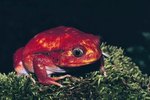
Tadpoles appear when the eggs of amphibians hatch. The eggs are laid in water, in tiny puddles or larger ponds. These tadpoles spend weeks growing and metamorphosing into their adult shapes. Tadpolestypically are associated with frogs, but they also serve as the immature forms of toads and salamanders.
What Tadpoles Have in Common
Tadpoles won't look the same necessarily when they grow up, but newly hatched, tadpoles have many similarities. They usually have large heads and mouths with long, thin tails. Tadpoles breathe mainly through gills, although they also diffuse oxygen through their skin. Usually between 1 and 2 inches long, tadpoles spend several weeks developing legs, lungs and thicker bodies before leaving the water.
Frogs
Frog tadpoles often have distinctive designs. Their bodies and tail might look mottled with different shades of brown and gray, or they might sport a couple of colors. Many have a dark stripe going down their tails surrounded by clear tail tissue. Frog tadpole body types vary; some have tails as thick as their heads, while others are more streamlined and look more like small fish. Their tails begin to shrink as the legs grow, eventually disappearing as the tadpoles turn into froglets.
Toads
Toad tadpoles appear somewhat drab compared to frog tadpoles. Most toad tadpoles are a single color, often dark brown or black. They have little color variation, although they might have a slightly lighter stripe down the tail, or light mottling. Their bodies tend to thicken into rounded bellies when the back legs become visible, often before the front legs start to grow.
Salamanders
Salamander larvae look similar to frog and toad tadpoles, but they develop slightly differently. Their heads typically are a bit smaller than frog and toad tadpoles, although they still have gills and the same basic tadpole shape. Instead of developing a thick center section, salamander tadpoles tend to stay thin, growing longer instead of thicker. Their back feet develop before their front feet, but they don't lose their tails like frogs and toads do.
References
- Illinois Department of Natural Resources: What Lives in My Backyard?
- Trent University: Tadpole Identification Table
- Hamline University: 'Frog'-quently Asked Questions (FAQ's)
- Forest Preserve District of Cook County, Illinois: The Salamanders
- U.S. Geological Survey: Tadpoles of the Southeastern United States Coastal Plain
- U.S. Geological Survey: A Field Guide to Amphibian Larvae and Eggs of Minnesota, Wisconsin, and Iowa
Photo Credits
-
Jupiterimages/Photos.com/Getty Images



